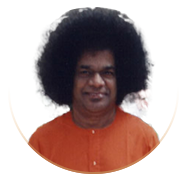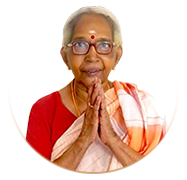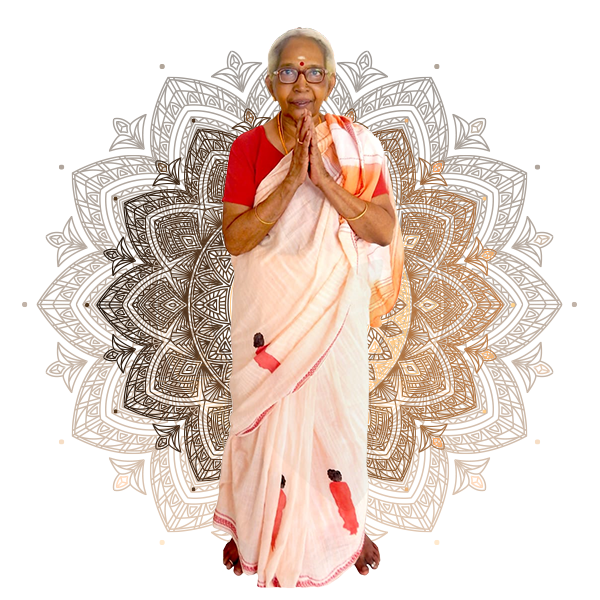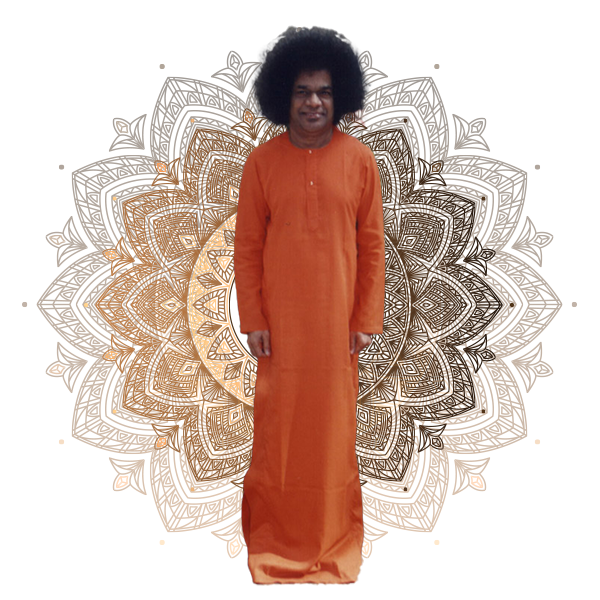DESCRIPTION
Sri Amruteswarar/Lord Shiva
The Trinity of Hindu Gods, that is, Brahma, Vishnu and Shiva, are associated with Creation, Preservation and Destruction, respectively. Shiva, the “Auspicious One”, is also known to be the destroyer or transformer God among the Trimurti. Shiva is an omniscient and omnipresent yogi or mendicant, who lives the life of a sage at Mount Kailas. In Shaivism, Shiva is seen as the Supreme God.
Image-wise, he is depicted as a handsome and strong man, deeply immersed in meditation or dancing the Tandava upon Apasmara, the demon of ignorance, in his manifestation of Nataraja, the Lord of the dance. Shiva is considered as having the authority over death, rebirth and immortality – he retains his youthful looks due to this quality. He is also the father of Ganesha and Karthikeya.
Shaivism, like Vaishnavism, is a major religious movement in India. Followers of Shaivism, called Shaivas or Saivites, revere Shiva as the Supreme Being. Shaivites believe that Shiva is the Ultimate God, the Creator, Preserver, Destroyer, Revealer and Concealer.
Shiva is portrayed as a powerful and rugged youth with matted hair, vibhuti and ash smeared all over his body (this indicates Shiva’s aspect of Bhairava, who is associated with ancient Tantra and cremation-ground asceticism), having a Third Eye, wielding the Trishul or the Trident, represents the three Gunas. He wears a crescent moon on his head (which shows the control he wields over his own mind, through the waxing and waning phases of the moon) and the matted Jata on his head holds the Ganga (the flow of the Ganga implies the nectar of immortality), who constantly spouts a thin stream of water.
Normally in a highly meditative mood, Shiva opens his third eye only when he is deeply disturbed. This action usually causes massive destruction. He had once burnt down Kama, the God of Love, when the latter tried to disrupt his penance. But Shiva also occasionally opened his third eye to create as well. In the case of Karthikeya’s birth, he had initially created six sparks, which turned into six children, which fused together to make one child with six faces. This was Karthikeya or Muruga.
Shiva is blue-throated and hence, he is also referred to as Neelakantha. This occurred in the Samudra Manthan episode, wherein Shiva drank the deadly Halahala poison that churned up from the Ocean of Milk.
Shiva is often shown seated upon a tiger skin, also wearing tiger skin around his waist. This is an honour reserved only for the most powerful Hindu ascetics, the Brahmarishis. Tiger represents lust. Hence, his sitting on the tiger’s skin indicates that He has conquered lust.
Shiva rides the Nandi, the Bull. The Rishabha or the Bull represents the Dharma Devata, the Deity of Righteousness. The Ganas are his attendants. Surrounded by dance and music, accompanied by his consort Parvati, Shiva resides in the frigid peaks of Mount Kailas.
Shiva is given several opposite attributes. While he is the Destroyer, he is also considered the Benefactor. While he is concerned with the cremation ground, on the one hand, he is also considered equally auspicious. In fact, the name Shankara, means, “the one who does good”. Hence, while he is terrible and fearful in his aspect as the Mahakala, he is equally calm and benevolent in his form as the Dakshinamurthy or the Divine Teacher.
The other strange aspect of Shiva is that he is essentially a Yogi, yet, he is a loyal householder, a loving husband and a doting father of two. The form of the Ardhanarishvara, shows Shiva as the fusing of himself and Parvati in one single body.
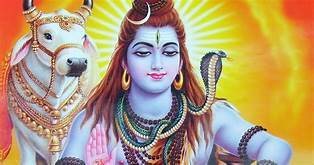
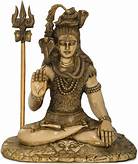
RITUAL WORSHIP
Offerings, Rituals and Pooja
Shiva is worshipped all over India and there are hundreds of temples and shrines dedicated to him, mostly in the form of a Shiva Linga and sometimes as an idol in human form. Typically, offerings to Shiva are very simple – flowers (except the Ketaki), Bel leaves, milk and sandalwood paste are supposed to please him. The prayer is a particular arati to Shiva and numerous hymns and poems in his praise.
The worship of Shiva in the form of a Linga, is very important . The Linga is commonly found in the shape of a vertical rounded column. Shiva means auspiciousness, and Linga means a sign or a symbol. Hence, the Shivalinga is regarded as a symbol of the great God, who is also the Auspicious One. The egg shape of the Linga also indicates a source of evolution – the Cosmic Egg. The taper at the top of the stone can be likened to the eternal flame of light – the source of all knowledge – or the Jyotir Linga (Jyoti indicates light).
BENEFITS OF WORSHIP
Lord Shiva is the lord of mercy. He guards the devotees since evil forces, trouble and suffering.
Shiva’s dance is associated with a specific Hindu ritual in which it is said that on every 13th evening of the bright lunar fortnight, there exists an hour called the Pradosha when, if Shiva is propitiated, it is said to be the equivalent of offering one’s worship to all powers of the cosmos. It is said that at this hour, all gods assemble at mount Kailash (Shiva’s abode) to lose themselves in the magic of Nataraja’s dance.
Shiva is often propitiated by unmarried Hindu girls because of his unsurpassed qualities of love and generosity. He is considered an ideal husband in spite of his being an ascetic and is worshipped in the hope of having a husband with his ideal characteristics.
For more please see also the Mantra Benefit tab
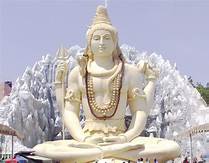

MANTRA OR SLOKA FOR INVOCATION
Mahamrityunjaya Mantra
OM. Tryambakam yajamahe Sugandhim pushti-vardhanam Urvarukamiva bandhanan Mrityor mukshiya mamritat
We Meditate on the Three-eyed reality
Which permeates and nourishes all like a fragrance.
May we are liberated from death for the sake of immortality,
Even as the cucumber is severed from bondage to the creeper.
This mantra is dedicated to Lord Shiva because Mrityunjaya is the other his name and it means who wins over death. Lord Shiva is said to be immortal and is known as the end of death.
Mantra Benefit
Lord Shiva is the most powerful in this whole universe and regular recitation of this mantra will make him happy and he can give a long life as a blessing and body free from disease and bring calmness in the face of death. This Mantra is a call for enlightenment and is a practice of purifying the karmas of the soul at a deep level. It is also said to be quite beneficial for mental, emotional, and physical health.
Panchakshari Shiva Mantra – ‘Om Namah Shivaya’
The most well-known and basic Shiva Mantra simply translates to ‘I bow to Lord Shiva’.
Mantra Benefit
It is dedicated to Lord Shiva and if chanted 108 times every day, this mantra will help you purify your body and Lord Shiva will shower his blessing on you and protect you from all the evil forces. It fills your life with positivity and happiness.
Rudra Mantra – ‘Om Namo Bhagavate Rudraya
The literal translation of this mantra is “I bow down and seek blessings from Lord Rudra”. This is one of the most powerful and simplest Rudra mantras used widely for holy chants, worship and meditation.
Mantra Benefit
This mantra will make sure all your wishes get fulfilled along with the blessings of Lord Shiva.
SPECIAL DAY OR FESTIVAL
Monday is dedicated to the worship of Lord Shiva and his consort, Goddess Parvati. Their Elephant-Headed Son, Lord Ganesha, is propitiated at the beginning of the worship. Devotees visit Shiva temples and sing in praise of the Lord on this day.
Shiva is associated with Chandra or the Moon. His color is white and the gemstone associated with him is the pearl.
The worship or the Monday fast is observed from sunrise through sunset and the fast is broken only after evening prayers. It is believed that devotees who undertake this, will be granted wisdom and will be able to fulfil all their desires. Those facing marital troubles perform this, in order to experience a better conjugal life. In some cases, unmarried women undertake this worship, in order to attract their ideal life partner.
The most important prayers to invoke and please God Shiva are also done on Pradosha, the thirteenth day of every fortnight in Hindu calendar.
Important Festivals
Maha Shivaratri
The Maha Shivaratri is the main festival of Lord Shiva. Celebrated annually on the 13th night or the 14th day of the new moon in the Krishna Paksha of the month of Maagha or Phalguna (in January or February) in the Hindu almanac. Through the night green leaves are showered on Shiva’s image. Shivaratri also marks the night when Lord Shiva married Parvati. On this sacred day, the devotees observe fast and offer fruits, flowers and Bel leaves to the Shiva Linga. Almost every year, since 1940 when Sri Sathya Sai Baba announced that He was Sai Baba ‘who came again’, the emergence of one Linga (or many) from His Body through His mouth has taken place, during the Lingodbhava muhurtha (the auspicious moment during Maha Shivaratri for the exterior manifestation of the symbol of the all-pervasive Divine Principle).


Nandi
Nandi, (‘The Happy One’) Shiva’s divine vehicle is represented as a white bull, symbolizing purity and justice. An image/statue of Nandi is placed in the outer hall of Shiva temples, and looks towards Shiva. Shiva and Nandi’s symbolic association can be traced back to the days of the Indus valley civilization. During those ancient times, dairy farming was one of the primary occupations, thus explaining the appearance of various artifacts indicating a deity much like Shiva. This deity is believed to have been worshipped as the keeper of herds. This deity over time was converted into the present day Shiva, with the bull Nandi as his primary vehicle. The name Pashupatinath – or lord of creatures – can also be ascribed to the ancient deity of the people of the Indus Valley Civilization. Nandi himself later acquired the status of a lesser God and there are several temples in India dedicated independently to Nandi. However the presence of a statue of Nandi at the gate of the Garbha Griha (sanctum sanctorum) of every Shiva temple is a must and marks the close association of Shiva with Nandi. In Sanskrit, a bull is called Vrisha, which has another connotation – that of righteousness or Dharma. Thus through Nandi, righteousness or Dharma become an integral part of Shiva’s aura.
Nagas around the Shiva
Shiva is typically depicted with a snake around his neck. Often additional snakes are depicted – one, as a sacred thread around his body, and two more, around his wrists as bracelets or his arms as armlets. Having the snakes wrapped around him suggest his control over desire and the sensual world and the lack of effect that maya (illusory world) has on him. The snakes also stand for the yogic power of kundalini, which is typically depicted as a coiled serpent lying dormant in the muladhara chakra or one of the lower spiritual levels of all beings. The serpent gradually uncoils and moves upward as one taps into his own spiritual self through yogic means. However one needs to be aware of the huge energy stored in the kundalini and must learn not only to release it but also to control it. The depiction of snakes along with Shiva, indicate that Shiva is the master of this cosmic energy and controls it the way he deems fit.

-
[12] 5.0 - 5.5.1 >Prakarams of Mukthi Stupi
- 5.0.1 - Apsaras
- 5.1 - First Prakaram of Stupi
- 5.2 - Second Prakaram of Stupi
- 5.2.1 - Sri Sathya Sai Baba Padukas
- 5.3 - Third Prakaram of Stupi
- 5.3.1 - Sri Kakabhujandar
- 5.3.2 - Sri Bahula Devi
- 5.4 - Fourth Prakaram of Stupi
- 5.5 - Fifth Prakaram of Stupi
- 5.5.1 - Mukthi Stupi
-
[18] 101-109 >Munis & Consorts-part B
- 101.0 - Kutsar
- 101.1 - Anugraha Devi
- 102.0 - Roma Rishi
- 102.1 - Prema
- 103.0 - Adi
- 103.1 - Anupama
- 104.0 - Shukracharya
- 104.1 - Sukeerti
- 105.0 - Durvasar
- 105.1 - Indira
- 106.0 - Angirasar
- 106.1 - Akshaya Devi
- 107.0 - Pulasthiyar
- 107.1 - Rama Devi
- 108.0 - Pulaha
- 108.1 - Manohari
- 109.0 - Vyagrapada
- [12] 5.0 - 5.5.1 >Prakarams of Mukthi Stupi
- 5.0.1 - Apsaras
- 5.1 - First Prakaram of Stupi
- 5.2 - Second Prakaram of Stupi
- 5.2.1 - Sri Sathya Sai Baba Padukas
- 5.3 - Third Prakaram of Stupi
- 5.3.1 - Sri Kakabhujandar
- 5.3.2 - Sri Bahula Devi
- 5.4 - Fourth Prakaram of Stupi
- 5.5 - Fifth Prakaram of Stupi
- 5.5.1 - Mukthi Stupi
-
[18] 101-109 >Munis & Consorts-part B
- 101.0 - Kutsar
- 101.1 - Anugraha Devi
- 102.0 - Roma Rishi
- 102.1 - Prema
- 103.0 - Adi
- 103.1 - Anupama
- 104.0 - Shukracharya
- 104.1 - Sukeerti
- 105.0 - Durvasar
- 105.1 - Indira
- 106.0 - Angirasar
- 106.1 - Akshaya Devi
- 107.0 - Pulasthiyar
- 107.1 - Rama Devi
- 108.0 - Pulaha
- 108.1 - Manohari
- 109.0 - Vyagrapada
